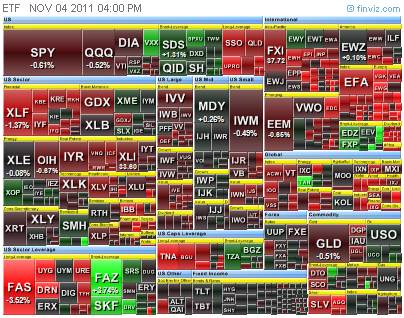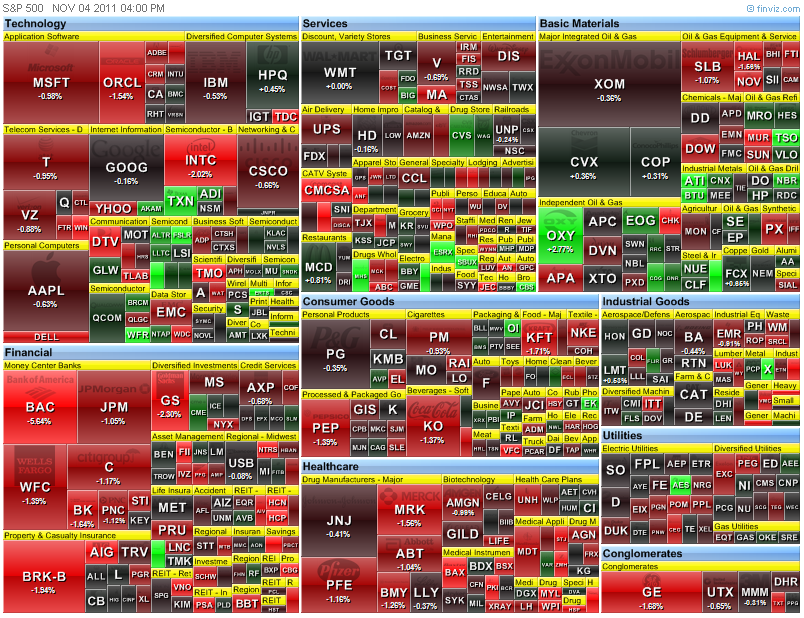"Are you riding a dead horse?
Get off and get on a live one."
— Richard D. Wyckoff




Continue from Part 1:
For example, the first 3 charts above show the 9 sector Exchange-Traded-Funds (ETF) in the S&P500 plus the Dow Jones Real Estate ETF. There are:
XLB: Basic Material Sector
XLE: Energy Sector
XLF: Financial Sector
XLI: Industrial Sector
XLK: Technology Sector
XLP: Consumer Staples Sector
XLU: Utilities Sector
XLV: Healthcare Sector
XLY: Consumer Cyclic Sector
IYR: Dow Jones Real Estate Sector
If one would follow a typical classic investment methodology call - Dollar Cost Averaging Method... He would absolutely not make any profit from the past 10 years of investment! (We are not even talking about money devaluation due to inflation here.)
Diversification:There are many investment books suggested that one should invest into all sectors proportionally to the fundamental strength or future prospect... That's also a BS!
Yes. One should diversify their investment INTO A FEW LEADING SECTORS, but not all sectors.
Diversification is a widely accepted tactics in reducing risk... and it always tie with a classic phrase: "Don't put all the eggs into one basket."
Well, it is quite true, especially in this chaotic financial world that the fundamental books are mostly cooked and rotten! This is particularly true to those who invest in individual stocks. One can choose to reduce risk by using the ETF as an investment vehicle. In general, they consist of few tens of stocks as component. That serves as a good way to diversify the risk.
I hear of people who say they are good at diversification.... And they would buy into many individual companies in the same sector. And, when the sector goes down, all his stocks go down together.
Long and Short:
Most people know how to buy a stock... But, not sure how to short the stock.
In fact, in order to short a stock, one must open a margin account in order to do so. And, one must be very careful with their margin account, or he would get margin call if he is over trade outside some safety margin.
Here are the good news.:-)
Today, in this advanced financial market, there are something call Inverse ETF. Basically, they move in opposite direction with the particular sector. Take for example, if the Basic Material is up by 2%, the Inverse ETF on that corresponding sector would down by 2%, and many inverse ETFs are using 2 times leverage. This means that it would move down by 4% instead of 2%.
Point for Ponder:
The S&P500 factsheet stated that the it has a market coverage of approximately 75% of the U.S. equities. And, every year, there are increasing in the money supply in the USA, in fact the increasing of money supply are quite high in recent years. As shown in the Chart 4 that the cumulated sum of money produced is much more than double in today as compare to 10 years ago!
Now, when money is created (or produced), they normally do not just hide under the pillow... They move! They move into bank as deposit, they move into stock market, and they move into real estate... And these are the three main places that money moves to.
Then here are a few simple and billion dollar questions:
WHERE HAVE ALL THESE MONEY GONE (OR HIDDEN)?
WHEN ARE THEY GOT TO SHOW THEMSELVES AGAIN?
WHERE ARE THEY GOT TO APPEAR? IN WHICH SECTOR?
And, the following article can provide some clue to get the answers:-
tape-reading---using-the-classical-tool-to-decode-the-market-5
"If you have a minute, I'll tell you how to make money in stocks.
Buy low and sell high -- now if you have five or
ten years, I'll tell you how to tell when
stocks are low and high."
— Jesse Livermore
.jpg)










0 Comments->:
Post a Comment